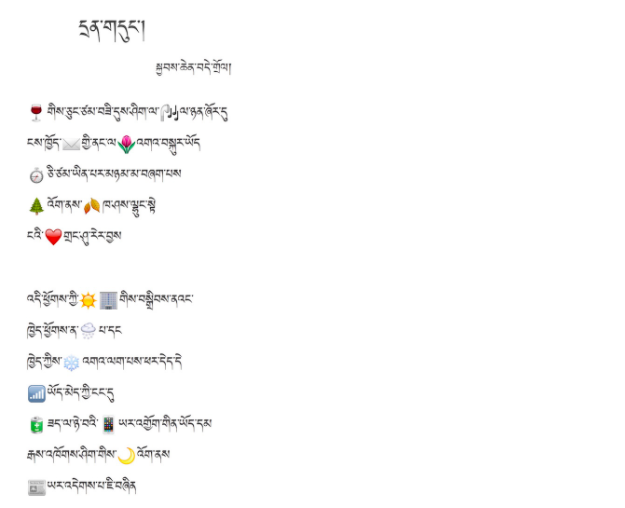
High Peaks Pure Earth presents a guest post by Lowell Cook* who has translated an emoji poem by contemporary Tibetan poet Kyabchen Dedrol and written an accompanying introduction.
As different screens render emojis differently, an image of the whole poem is inserted into the post at the end.
Thank you to Lowell Cook for another great submission! Please be sure to read his earlier contribution, an introduction to, and translations of, poetry by Sangdor and Kyabchen Dedrol.
Introduction by Lowell Cook
The leader of the Third Generation of Tibetan poets and head of the influential website Butter Lamp, Kyabchen Deydrol, has written a poem in Tibetan that has never been written before—a poem written with emojis!
This poem was published in October of 2015 and has since been growing steadily in popularity. It was probably first written as a joke to put words (and emoticons) to the painful emotions of checking your phone for a response from your crush. And what better a way to express such longing and heartbreak than with little digital flowers and hearts. Despite being a one-off poem, it’s effect has been noted. You can see young Tibetans using emojis mixed with Tibetan in a similar manner in WeChat posts, followed by their friends commenting on them and calling them Deydrol posers.
It’s not only in Tibetan literature that emojis are being used. Herman Melville’s classic Moby Dick has been translated entirely into emoticons. This new work, aptly titled Emojidick, was funded by crowdsourcing, “translated” by Amazon Mechanical Turk workers three times, and then the best translations were selected by still more workers. Some rather interesting emoji poetry, or poemoji, is also being “written” these days. It is hard to say whether these resemble paintings or poetry but the form certainly speaks for itself. Here is a Tumblr account dedicated to these interesting works of art. The list goes on—the Bible is being translated into emojis, there is an emoji movie, and there is even a so-called emoji sutra from 18th century Japan. There are bound to be many other creative ways in which emojis are being used. However, this all goes to show that Tibetan literature language is not restricted to dusty scriptures as many would think. No, instead it is very much alive and thriving. It would seem that, paradoxically, it is innovation that is providing Tibetans with a powerful means of preserving their culture and language.
That said, I would like to share my translation of Kyabchen Deydrol’s poem Longing with you all. Part of the fun of reading a poem with emojis is that each emojis can be understood in different ways. Much like poetry itself, different readers will have different interpretations. There is no system of grammar associated with emojis, however you can often tell the exact word Kyabchen Deydrol had in mind based on the spelling of the particle that follows the emoji. This made translating this poem feel like an enjoyable, if not challenging, guessing game. The majority of emojis took the place of nouns. Of the two emojis that were verbs, the 💨 was nearly impossible for me to make sense of. I had to ask the author himself what he intended. You will see that some of my emojis don’t match his, but that’s okay! After all, why can’t one emoji be translated with another?
“Longing”
By Kyabchen Dedrol
Translation by Lowell Cook
Slightly drunk off 🍷, I was listening to some 🎧
And sent you a few 🌷 in a ✉️.
Not paying attention to the 🕣
🍂 fell beneath the 🌲
And my ❤️ grew ever cold.
The ☀️ here is obscured by 🏢.
Is it 🌧ing where you are
And are you busy brushing some ❄️ off?
Are you holding up your 📱 that’s about to run out of 🔋
To check whether or not you have 📶
Just like an old man trying to read the 📰
Under 🌙 light?
In a dream, I am stuck between ⛓
And ⚙️ as I 💨 at someone wielding a 🔫.
I’m afraid you might’ve been carried off by a 🌪.
I’m 😨 that you may be poisoned
By some tricky treats given to you by 👦.
When I awake, I am 💔,
But you’re still among your 👨👨👦👦 as before.
The 📲 I get from you is this: 🐷
And my heart fills with ❓❓❓
October 28, 2015
*Lowell Cook lives in Chengdu where he translates Buddhist scripture and contemporary Tibetan literature.
Image version below:






Dear HPPE,
Do you maybe know how is it called in Tibetan an emoji poem or poemoji?
Or the expression used by the author (either in Tibetan or some Chinese mixed form)?
Thanks so,
Warm regrds,
LM
Hi Lara, here is a note from the translator: “My IT dictionary gives སེམས་ཁམས་མཚོན་རྟགས for emoticons, but in colloquial speech I’ve heard them just called རི་མོ. I don’t think there is actual term for emoji poetry but it’s not really a genre (yet). As far as I know Kyabchen Deydrol’s is the only one that’s actually been circulated widely. Sorry I don’t have more information, but hope that is somewhat helpful.”